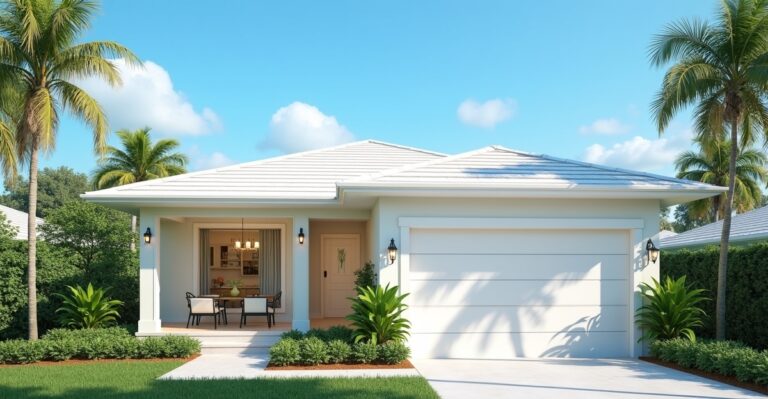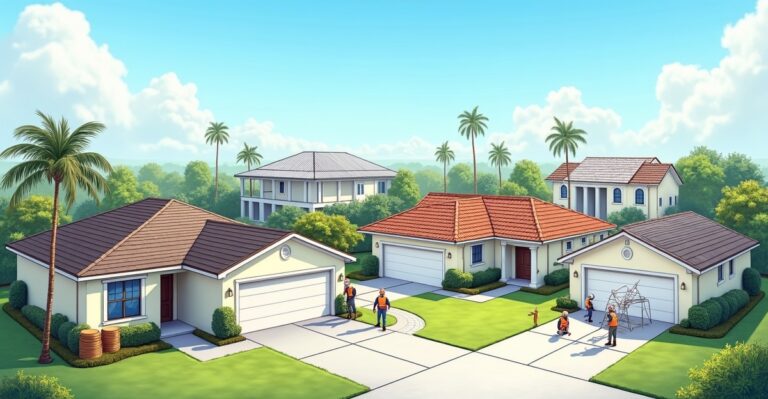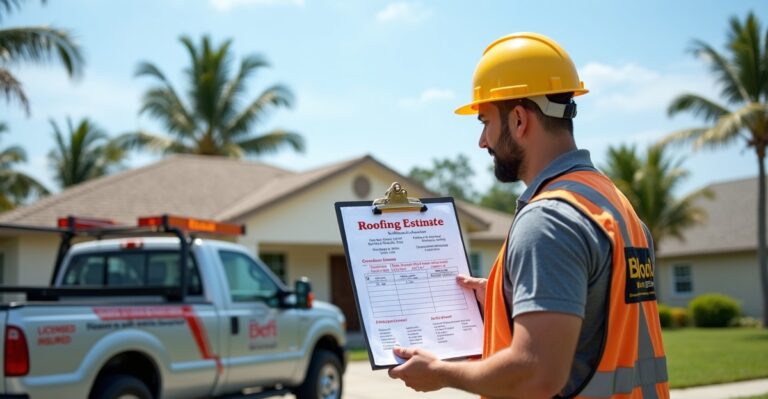Do Skylights Cause Roof Leaks?

Skylights often get blamed for roof leaks, but the real issue usually lies elsewhere. Installation errors, worn-out seals, or storm-related damage around the skylight are the usual culprits. If we’re wondering whether skylights cause leaks, it really comes down to how well they’re installed, local weather patterns, and the level of maintenance they receive.
Key Takeaways
- Most leaks involving skylights come from poor flashing, cracked seals, or roof material damage near the unit—rarely from the skylight itself.
- Florida’s climate—with intense rain, strong winds, punishing sun, and salty air—speeds up the aging process of skylight components.
- Deck-mounted skylights need a tighter seal than curb-mounted models, particularly in areas that see frequent storms.
- Common early signs of a potential leak include stains on the ceiling, dripping water during rain, rust on the frame, and moisture buildup inside.
- Schedule routine roof checks, especially after strong storms, and always work with experienced local professionals to reduce the risk of skylight leaks.

What You Really Need to Know About Skylights and Roof Leaks
Skylights add natural light and charm—no doubt about it. But we’ve found homeowners often ask, “Do skylights cause roof leaks?” The short answer is: not if they’re installed and maintained the right way.
Most of the time, the skylight itself isn’t the problem. It’s how it’s installed. A roof leak around a skylight is usually caused by poor flashing, improper sealing, or rushed installation that doesn’t account for Florida’s heavy rains and wind. That’s why working with a trusted roofing contractor in Florida is so important.
Main Causes of Skylight Leaks
A few key factors tend to lead to skylight leaks. Understanding them helps prevent future headaches.
Here are some of the most common causes of skylight leaks:
- Faulty installation: Most leaks stem from shortcuts taken during installation. Flashing must be correctly layered, and the window sealed tightly.
- Seal failure: Over time, skylight seals can weaken or crack. In Florida’s humid climate, that process can speed up.
- Roofing issues around the skylight: Damaged shingles or underlayment nearby can disguise themselves as skylight leaks.
- Debris buildup: Leaves and branches may clog drainage paths, leading water to pool and seep in.
- Storm damage: Frequent hurricane-force winds and flying debris can crack skylight glass or flashing, resulting in leaks.
If you’re wondering whether your skylight issue is repairable, know that many leaks can be addressed with the right attention. We’ve answered that in depth in our guide: can a roof be repaired instead of replaced.
Florida Weather Requires Extra Care
Because Florida gets more moisture than most other states, installing a skylight here takes precision and planning. We use weather-rated materials and sealants that can stand up to UV exposure, salt air, and sudden downpours. A skylight that’s properly installed and maintained shouldn’t leak—even during storm season.
That said, after major storms hit, having your roof inspected is smart. Heavy winds can lift shingles or damage flashing, which increases the risk of skylight leaks. If you’re unsure what’s storm-related and what isn’t, check out this article: can storm damage be covered by insurance.
We recommend regular inspections of your entire roof system, too. Learn more in our post on how often roofs should be inspected. Spotting early signs of wear could save thousands down the line.
If you’re planning a new installation or replacing an old unit, our skylight installation service focuses on long-term performance—no cut corners, no guesswork. We’ll help protect your home and brighten up your living space the right way.

Common Causes of Skylight Leaks: It’s Not Always the Window
We often hear folks blame the window itself when a skylight starts to leak. The truth is, the glass is rarely the problem. Most skylight leaks actually start with the materials and roofing details that surround it—not the pane of glass.
What Actually Causes Skylight Leaks
Several common factors lead to leaks, and most tie back to how water moves across your roof. Here’s where things usually go wrong:
- Improper flashing installation: Flashing is the thin metal used to guide water away from the skylight and into your gutters. If it’s missing, bent, or poorly fitted, water can seep underneath. We see this a lot in rushed installs or DIY jobs. It’s one of the leading causes of skylight leaks.
- Aging or dried-out sealants: Over time, the rubber or silicone around a skylight can dry, crack, or separate from the surface. Florida’s long sunny seasons speed up this wear. Once these seals fail, rain works its way through even the smallest gaps.
- Cracked or warped skylight frames: With years of heat, humidity, and storms, skylight frames can expand, shrink, or even crack. Once that frame shifts out of place, water won’t drain as it should. If you see discoloration or staining nearby, it may point to a structural change in the frame.
- Roofing damage near the skylight: Even if the skylight is installed correctly, damage in the surrounding shingles or decking can affect how water runs off the roof. Think of it as the domino effect—one loose or missing shingle can send water toward the skylight, pushing moisture into any weak areas.
If you’re already seeing signs of water but aren’t quite sure what’s causing it, our roof repair experts can pinpoint the issue and help keep further damage from spreading.
Choosing the Right Skylight Structure
Skylights come in two common types: deck-mounted and curb-mounted. Understanding the difference helps reduce problems down the line.
- Deck-mounted skylights sit directly on the roof deck. They’re sleeker and lower profile but can be more prone to water intrusion if not sealed just right. In areas with heavy rainfall or wind-driven storms, this style needs extra attention during installation.
- Curb-mounted skylights are installed on a raised curb—usually a wooden frame—before the skylight is mounted on top. They create a higher barrier against water, which makes them a good option for storm-prone regions like Florida. The elevated curb gives flashing more surface to grip and seal properly.
If you’re exploring new options or upgrades, our skylight installation team in Florida can walk through the specific needs of your roof and climate. We’re happy to help you weigh the pros and cons based on your home’s location, pitch, and existing roof type.
Installation matters just as much as the materials themselves. Even a well-made skylight won’t stay watertight if the surrounding flashing or roof layers weren’t handled right. That’s why choosing a professional who understands how to install skylights correctly in Florida’s climate is key.
If you’re dealing with water stains or moisture near a skylight, don’t assume the window’s at fault. It might be the system around it—flashing, sealant, shingle layout, or underlying roof wear. Sometimes, those issues can be fixed with a sealant or flashing rework. Other times, deeper repairs near the skylight or even a partial roof replacement might be needed to stop the leak for good.
For anyone curious about handling leaks early, here’s a helpful guide on whether roof leak repairs can be done yourself. And as always, we’re here to help keep things dry and stress-free.

Clear Signs You Might Have a Skylight Leak
Staying ahead of a potential roof leak around a skylight helps stop damage before it spreads. Skylight leaks can start small but quickly affect ceilings, insulation, and your peace of mind. Knowing what to watch for makes all the difference.
We’ve seen firsthand how early action keeps repair costs down and helps protect your home. Here are some of the most common signs of a skylight leak to look out for:
Visual and Physical Indicators
Keep an eye out for these warning signals around or below your skylight:
- Water stains or brownish spots on ceilings or walls near the skylight
- Dripping water during or just after heavy rainfall
- Paint peeling or drywall bubbling near the interior edge of the skylight
- Rusted, corroded, or discolored screws, frames, or flashing
- Persistent condensation inside the glass, even on warm days (can signal trapped moisture or poor insulation)
Not all moisture around a skylight means a direct leak. For example, condensation between glass panes could mean a seal failure, while moisture around the trim may point to poor ventilation. But if you notice these signs sticking around—or getting worse—it’s time to act.
Why Early Detection Matters
Skylight leaks rarely stay isolated. Water can travel behind walls or under roofing materials, turning a minor drip into widespread hidden damage. Catching these signs early prevents problems in your attic, insulation, or structural framing.
If you notice any of these issues, don’t wait it out. Consider scheduling a professional roof inspection and repair. In some cases, the skylight itself is sound—but flashing or surrounding shingles may need attention. Identifying the root cause can also help determine whether a roof repair is enough or if further work is needed.
We also recommend regular roof checkups, especially after storms or as your roof ages. If you’re unsure how often to book one, read through how often roofs should be inspected for a helpful breakdown.
For homeowners considering new features or skylight upgrades, working with experienced installers reduces the chances of future leaks. Explore our skylight installation services if you’re planning something new or replacing outdated windows.
Spotting these signs early gives us time to act before your roof and ceiling take the hit. It keeps your skylight adding light—without letting in water.

How Florida Weather Makes Skylight Maintenance Even More Important
Florida’s intense sun, heavy rain, and high winds test every part of a roof—but skylights take on more strain than most. In our climate, maintaining a skylight isn’t just smart. It’s essential for preventing leaks and avoiding costly damage.
Why Skylights Need Extra Care in Florida
Our combination of harsh UV rays, salty coastal air, and seasonal hurricanes exposes skylights to year-round wear. Over time, even top-quality installations can show signs of stress. Here’s what puts skylights at greater risk in Florida:
- Coastal moisture: Salt-laden air wears down sealants and corrodes skylight frames faster than in inland environments.
- UV exposure: Constant sun breaks down the rubberized components and skylight dome materials, leading to brittleness and cracks.
- High winds: Gale-force gusts from tropical storms or hurricanes can lift materials or drive water beneath even a well-installed unit.
- Flying debris: Branches and airborne objects during storms can damage skylight glass or the surrounding flashing.
During a hurricane, rafters and roofing connections experience up to 30 pounds of uplift per square foot. Skylights add natural openings to the roof, so if flashing or seals weaken, leaks become more likely. Combine that with the state’s average annual rainfall of over 50 inches, and it’s clear why skylight upkeep matters.
Routine maintenance and inspection are key. We suggest getting a professional roof inspection in Florida at least once a year—or directly after a major storm. These checkups help catch small issues with seals or flashing before water finds its way inside your home.
If water stains appear around a skylight or you notice fogging between glass panes, these could be early warning signs. Depending on the damage, it may be possible to repair rather than replace. When in doubt, we recommend consulting with professionals trained in both inspections and skylight installation in Florida.
Storm season also raises another concern: insurance claims. If damage results from wind or debris, homeowners may qualify for coverage. You can read more about that in our article on insurance coverage for storm damage.
Even in non-hurricane months, excessive humidity and rain can sneak past weakened seals. That’s why skylight care shouldn’t wait until water drips in. With regular inspections and prompt roof repair, we can extend the life of your skylight and roof frame and keep your home watertight.
Florida’s building codes require roofing systems to meet high uplift resistance and waterproofing standards. But codes alone don’t prevent wear and tear—routine prevention does. We’re here to help if you suspect a leak or simply want peace of mind.

Prevention Tips Every Florida Homeowner Should Know
Florida’s heat, heavy rains, and hurricane seasons can put any roof to the test—especially skylights. While skylights don’t automatically cause roof leaks, poor installation, bad seals, or storm damage can quickly lead to problems if left unchecked. Regular care goes a long way in helping prevent roof leaks and keeping your skylight functioning properly year-round.
Key Steps to Help Prevent Leaks Around Skylights
Taking consistent action before issues arise will save us stress and money down the line. These practical steps can help protect your home:
- Inspect flashing regularly: Flashing is the metal sealing that keeps water out around the edges of your skylight. After any major Florida storm, take time to visually check for lifted edges, corrosion, or missing sealant. Consider scheduling a professional roof repair if any problem signs appear.
- Keep skylight lenses clean: Leaves, dirt, and branches can collect and clog drainage areas around the skylight. A clogged water channel increases moisture buildup and raises the chances of leaks.
- Seal checks during seasonal maintenance: Seasonal home walkarounds are a good time to monitor the condition of skylight seals and nearby shingles. Catching minor issues early helps prevent much bigger repairs later.
- Use the right materials: Not all skylights are created equal. In hurricane-prone areas, we recommend investing in impact-rated skylights. They’re built to resist flying debris and reduce future damage risks, especially during Florida’s active storm seasons.
- Work with the right contractor: An experienced, licensed, and insured roofing contractor in Florida understands our climate and building codes. Proper skylight installation and flashing alignment make all the difference in leak prevention.
If your skylight starts showing signs of trouble—like interior water marks, musty smells, or discoloration around the frame—it’s time to address it fast. A leaking skylight repair should never be delayed, especially in our moisture-rich environment. Acting quickly can help avoid wood rot, mold growth, and insulation damage down the line.
Wondering whether a full replacement might be the smarter route? Check out this guide on whether a roof can be repaired or needs replacement—it applies to skylights too in many cases.
Proactive maintenance, high-quality materials, and the right team by your side reduce your skylight’s risk of leaking. By keeping up with inspections and repairs, we can enjoy natural light and style while safeguarding our homes from the elements.

When It’s Time to Call a Roofing Expert
Not every minor issue means reaching for the phone, but when it comes to a leaking skylight, we need to be extra cautious. Skylights have unique installation points that can make them more vulnerable over time—from worn flashing to cracked seals. While a bit of caulk or sealant might seem like a quick fix, most issues that lead to leaks hide under the surface.
That’s why diagnosing or fixing skylight leaks isn’t something we recommend handling alone. Climbing on the roof comes with obvious safety risks, and guessing at the source of a leak can lead to more damage if we’re wrong. A slow drip might seem manageable today, but if it points to compromised shingles or flashing, we’re likely looking at growing water intrusion and the potential for mold or rot.
Clear Signs You Should Bring in a Professional
There are a few key moments when it’s best to call in a licensed roofing contractor Florida residents can trust. Here’s what tells us a professional inspection is overdue:
- We’ve seen ceiling stains or damp spots forming around the skylight, especially after heavy rain.
- There’s visible moisture between the panes of a skylight or fog that doesn’t clear.
- Past leak attempts from homeowners or handymen haven’t stopped the water.
- The roofing material around the skylight looks worn, loose, cracked, or indented.
- We notice leaks becoming more frequent—or popping up during temperature swings or storms.
Any one of these means there’s likely compromised sealing or surrounding roofing elements. Acting early with a proper diagnosis can extend the life of our roof and skylight combination without jumping to expensive solutions.
If there’s uncertainty about whether a fix or full replacement is appropriate, we’re happy to talk through all options. To understand how repairs compare to full replacement, we break it down further in this guide on roof repair vs. replacement.
Skylights bring light, fresh air, and beauty into a space—but they also need strategic flashing and sealed placement to avoid roof leaks. These details vary depending on roof slope, roofing type, and even Florida’s unique rain patterns. That’s where a local expert makes a difference.
We base our recommendations on real roof inspection Florida experience—not guesswork. With Florida’s unpredictable weather, from hurricanes to humid summers, the roofing and skylight systems we install have to work harder than most. That’s why we provide honest feedback during inspections and only recommend what your home truly needs.
Our team specializes in leaking skylight repair as part of our comprehensive roof care. We combine roof knowledge with Florida-specific insight to protect both your ceiling and structural roofing components. That local experience isn’t just a bonus—it’s essential.
If there’s storm history involved, we can also guide on claims and insurance. Curious if your situation qualifies? This article details how storm damage may be covered.
Working with the right professional brings peace of mind. We protect your home from further damage, prioritize safety, and ensure any repair or replacement is built to handle Florida’s toughest seasons. If you’re wondering how to connect with a trusted roofing contractor, here’s how to choose the right roofer in Palm Coast.
If you’re concerned about a possible leak around your skylight, Pyramid Roofing Fla is ready to help with expert inspections and honest recommendations—backed by years of experience in Florida’s toughest weather.



